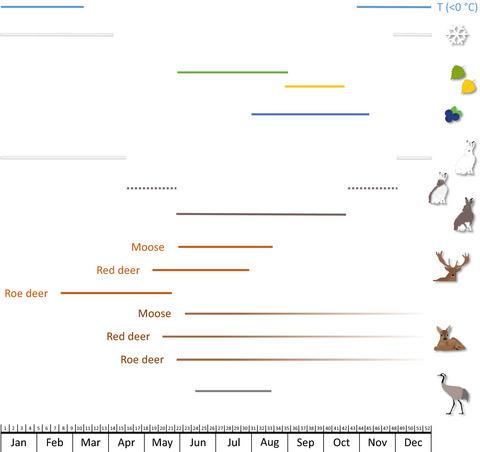当前位置:
X-MOL 学术
›
Remote Sens. Ecol. Conserv.
›
论文详情
Our official English website, www.x-mol.net, welcomes your
feedback! (Note: you will need to create a separate account there.)
Using by‐catch data from wildlife surveys to quantify climatic parameters and timing of phenology for plants and animals using camera traps
Remote Sensing in Ecology and Conservation ( IF 3.9 ) Pub Date : 2019-11-29 , DOI: 10.1002/rse2.136 Tim R. Hofmeester 1 , Sherry Young 1 , Sonya Juthberg 1 , Navinder J. Singh 1 , Fredrik Widemo 1 , Henrik Andrén 2 , John D. C. Linnell 3 , Joris P. G. M. Cromsigt 1, 4
Remote Sensing in Ecology and Conservation ( IF 3.9 ) Pub Date : 2019-11-29 , DOI: 10.1002/rse2.136 Tim R. Hofmeester 1 , Sherry Young 1 , Sonya Juthberg 1 , Navinder J. Singh 1 , Fredrik Widemo 1 , Henrik Andrén 2 , John D. C. Linnell 3 , Joris P. G. M. Cromsigt 1, 4
Affiliation

|
Gaining a better understanding of global environmental change is an important challenge for conserving biodiversity. Shifts in phenology are an important consequence of environmental change. Measuring phenology of different taxa simultaneously at the same spatial and temporal scale is necessary to study the effects of changes in phenology on ecosystems. Camera traps that take both time‐lapse as well as motion‐triggered images are increasingly used to study wildlife populations. The by‐catch data of these networks of camera traps provide a potential alternative for measuring several climatic and phenological variables. Here, we tested this ability of camera traps, and quantified climatic variables as well as the timing of changes in plant and animal phenology. We obtained data from 193 camera‐unit deployments during a year of camera trapping on a peninsula in northern Sweden aimed at studying wildlife. We estimated daily temperature at noon and snow cover using recordings provided by cameras. Estimates of snow cover were accurate, but temperature estimates were higher compared with a local weather station. Furthermore, we were able to identify the timing of leaf emergence and senescence for birches (Betula sp.) and the presence of bilberry berries (Vaccinium myrtillus), as important food sources for herbivores. These were linked to the timing of the growth of antlers and the presence of new‐born young for three ungulate species as well as the presence of migratory Eurasian cranes (Grus grus). We also identified the timing of spring and autumn moulting of mountain hares (Lepus timidus) in relation to snow cover. In this novel study, we show the potential of (by‐catch) data from camera traps to study phenology across a broad range of taxa, suggesting that a global network of camera traps has great potential to simultaneously track wildlife populations and the phenology of interactions between animals and plants.
中文翻译:

利用野生生物调查中的兼捕数据,利用相机陷阱对植物和动物的气候参数和物候期进行量化
更好地了解全球环境变化是保护生物多样性的一项重要挑战。物候变化是环境变化的重要结果。为了研究物候变化对生态系统的影响,必须在相同的时空尺度上同时测量不同分类单元的物候。同时拍摄时间和动作触发图像的相机陷阱越来越多地用于研究野生动植物种群。这些照相机陷阱网络的副渔获物数据为测量若干气候和物候变量提供了潜在的替代方法。在这里,我们测试了相机陷阱的这种能力,并量化了气候变量以及动植物物候变化的时机。我们在瑞典北部一个半岛上的193年摄影机诱捕过程中获得了193个摄影机部署的数据,目的是研究野生动植物。我们使用相机提供的录音估算了中午和下雪的每日温度。积雪的估计是准确的,但温度估计比本地气象站高。此外,我们能够确定桦树叶片出芽和衰老的时间((Betula sp。)和越橘浆果(Vaccinium myrtillus)的存在,它们是食草动物的重要食物来源。这些因素与鹿角的生长时间,三个有蹄类动物的新生幼年以及迁徙的欧亚鹤类(Grus grus)的存在有关。我们还确定了与雪盖相关的山地野兔(Lepus timidus)春季和秋季换羽的时间。在这项新颖的研究中,我们显示了来自相机陷阱的(副渔获物)数据研究广泛的生物分类的物候的潜力,这表明相机陷阱的全球网络具有巨大的潜力,可以同时追踪野生动植物种群和相互作用的物候在动植物之间。
更新日期:2019-11-29
中文翻译:

利用野生生物调查中的兼捕数据,利用相机陷阱对植物和动物的气候参数和物候期进行量化
更好地了解全球环境变化是保护生物多样性的一项重要挑战。物候变化是环境变化的重要结果。为了研究物候变化对生态系统的影响,必须在相同的时空尺度上同时测量不同分类单元的物候。同时拍摄时间和动作触发图像的相机陷阱越来越多地用于研究野生动植物种群。这些照相机陷阱网络的副渔获物数据为测量若干气候和物候变量提供了潜在的替代方法。在这里,我们测试了相机陷阱的这种能力,并量化了气候变量以及动植物物候变化的时机。我们在瑞典北部一个半岛上的193年摄影机诱捕过程中获得了193个摄影机部署的数据,目的是研究野生动植物。我们使用相机提供的录音估算了中午和下雪的每日温度。积雪的估计是准确的,但温度估计比本地气象站高。此外,我们能够确定桦树叶片出芽和衰老的时间((Betula sp。)和越橘浆果(Vaccinium myrtillus)的存在,它们是食草动物的重要食物来源。这些因素与鹿角的生长时间,三个有蹄类动物的新生幼年以及迁徙的欧亚鹤类(Grus grus)的存在有关。我们还确定了与雪盖相关的山地野兔(Lepus timidus)春季和秋季换羽的时间。在这项新颖的研究中,我们显示了来自相机陷阱的(副渔获物)数据研究广泛的生物分类的物候的潜力,这表明相机陷阱的全球网络具有巨大的潜力,可以同时追踪野生动植物种群和相互作用的物候在动植物之间。










































 京公网安备 11010802027423号
京公网安备 11010802027423号